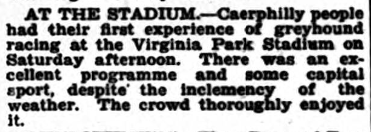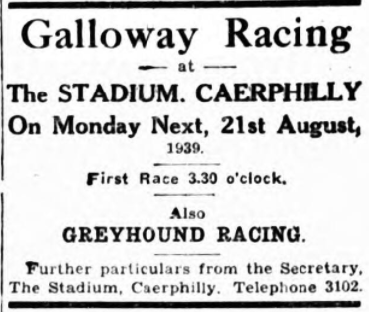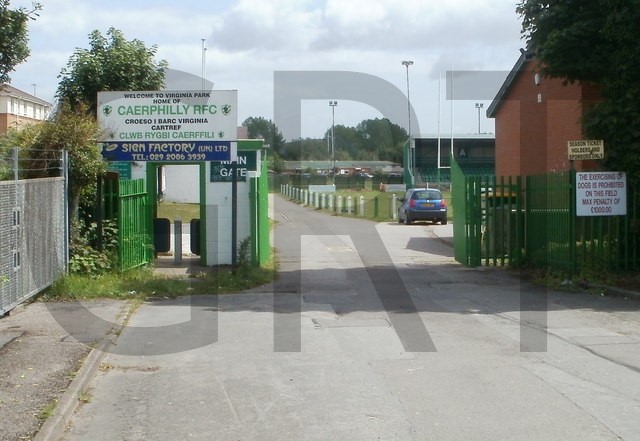Virginia Park, Caerphilly, South Wales.
POSTCODE———————————CF83 3JA
LOCATED————————————The town of Caerphilly lies roughly 8 miles north of Cardiff, with the venue situated less than a quarter of a mile north of Caerphilly town centre.
DATE CONSTRUCTED——————–Began during the late 19th century.
DATE CONSTRUCTED——————–Developed around the turn of the twentieth century.
DATE VENUE OPENED——————-1931
Meaning other sports may have taken place prior to the arrival of Greyhound Racing.
FIRST MEETING—————————–May 23rd 1931.
Greyhound Racing only.
LICENSED OR INDEPENDENT———-NGRC, then later independent.
All venues covered would have to be licensed with the government, licensed suggested in this section would refer to tracks operating under NGRC Rules.
INSIDE OR OUTSIDE HARE TYPE——Don’t know.
Please note that the Electric Hare suggested is only a guidance and would have been in operation for a certain amount of time at this venue. Although it is not necessarily guaranteed that it was operational all the time, as other types of lure may have been used and updated as time progressed.
DISTANCES———————————–300 and 575 Yards.
Please note that most racing venues distances had become varied throughout the years, the ones given above were at once point set and offers only a guidance to the track size.
CIRCUMFERENCE—————————Don’t know.
Please note that alterations at most racing venues throught its existence would see that the circumference of the track would vary, the one shown above offers only a guidance to the track size.
BIG RACE NAMES—————————Nothing known of.
STADIUM SHARED WITH——————Rugby Union, Boxing, Athletics and Cycling.
LAST MEETING——————————-Possibly August 21st 1939.
Greyhound Racing only.
STADIUM CLOSURE DATE—————-Possibly Late 1939.
Meaning other sports may have taken place after Greyhound Racing had ceased.
STADIUM DEMOLITION——————-During the Second World War.
BUILT ON SITE——————————-Caerphilly Rugby Union now play home matches on a totally different rebuilt stadium.
In some cases, structure’s that originally covered the venue after the stadium had been demolished, may have been themselves demolished too, so the one described is more likely to be the one which now presently covers the site.
EVIDENCE LEFT TODAY——————-Nothing known of the old venue.
FURTHER COMMENTS——————–None




The Welsh town of Caerphilly is situated eight miles north of Cardiff and becomes another addition to the list of towns that hosted greyhound racing amidst the valleys of South Wales. The greyhound track was located on a multi sports venue known as Virginia Park, a huge venue situated within half a mile of Caerphilly’s town centre. First signs of any sporting activities on the site began in 1887 on nothing more than a patch of grazing land, when an athletics track was temporarily marked out.
As time passed, the venue became more established, hosting other sports such as rugby union, boxing, hare coursing, harness racing, football and cycling, all featuring at some time or another around the turn of the twentieth century. In 1912 a fascinating event would take place that would remain in the minds of almost 20,000 people who gathered on a day that watched the landing of a bi-plane on Virginia Park. After a short spell the plane took off, but tragedy struck as the plane crashed in the nearby village of Trethomas. Strangely, nothing in the media reveals what happened to the pilot, all we can hope is that no news was good news and that the man survived. Another sport that featured was that of Dirt Track Speedway, which began in April 1931, but the sport failed to impress the locals before the cinder track was eventually removed after just one season only.
Yet it was the same year that witnessed the introduction of Greyhound Racing, seeing it run its inaugural meeting on the 23rd of May 1931. At the time it was described as Wales’s premier NGRC greyhound track, and because it was funded and controlled by the GRA their intentions were to overshadow the two thriving Cardiff venues. By the early 1930’s Virginia Park was developing into an impressive venue, its main feature being a large grandstand that could easily seat 5,000 onlookers.
Disappointingly, Greyhound Racing failed in its promise to outdo the other Welsh venues, and by 1934 with new legislation surrounding the sport had contribute to its failure. Greyhound Racing did continue at Virginia Park but only as an independent track, with a company called Galloway Racing promoting a cluster of meetings throughout the mid and late 1930’s. Advertisements in the local press for racing events featured during the summer months of 1939, but the final one dated August 19th suggested that Virginia Park’s last meeting took place August 21st 1939. Yet not only Greyhound Racing failed in its attempt to attract the public’s imagination, but the majority of all sports also failed in their contribution to fund the stadium, which made Virginia park financially unviable, and with the Second World War looming contributed to the stadium closure.
As the Second World War began to escalate, the stadium came under the control of the council, this time acting as a storage depot for the Fire Service. The town of Caerphilly also succumbed to air raids during the war, with Virginia Park suffering minimal damage as bombs landed close by. Once the hostilities had ceased Virginia park drifted into a state of disrepair, and it became clear that nobody was interested in rejuvenating the site, and by the end of the 1940’s it had become a total eyesore. The site had crumbled away into nothing more than a patch of waste ground full of rubble and uncontrollable vegetation, and that’s how it stayed until the 1960’s when a rugby club began to play on a newly laid out pitch within the grounds.
Caerphilly Rugby Club did eventually purchase the site, and gradually over the years rebuilt a dumping ground into the stadium along with a training pitch as it is today. No doubt Virginia Park has totally transformed into something unrecognisable from the days of greyhound racing and bi-planes and leaves no evidence at all of its problematic past.

Recent Comments